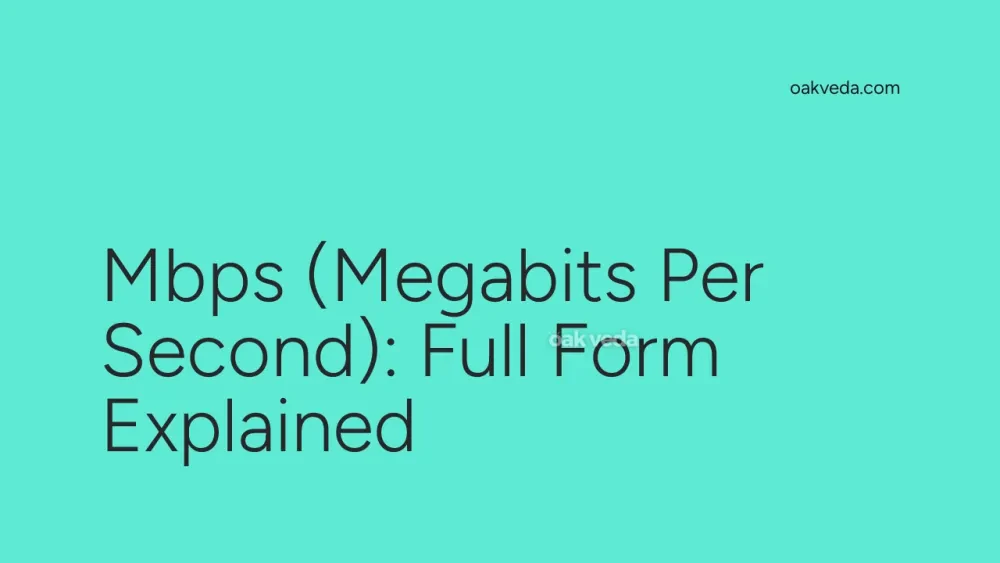
What is the Full Form of Mbps?
The full form of Mbps is Megabits per second. This abbreviation is commonly used in the context of internet speeds and data transfer rates. Understanding Mbps is crucial for anyone who uses the internet, as it directly impacts the quality and speed of online activities.
What is Megabits per Second?
Megabits per second (Mbps) is a unit of measurement used to quantify data transfer speeds in digital communication systems, particularly in internet connections. It represents the number of megabits (millions of bits) that can be transmitted in one second. This metric is essential for gauging the performance of internet connections and network equipment.
Origin and Development of Megabits per Second
The concept of measuring data transfer speeds in bits per second dates back to the early days of digital communication. As technology advanced and internet speeds increased, the need for larger units of measurement arose. Megabits per second became a standard measure as broadband internet connections became more widespread in the late 1990s and early 2000s.
How does Megabits per Second Work?
Mbps measures the rate at which data is transferred over a network connection. When you're downloading a file or streaming a video, the speed at which this content reaches your device is often expressed in Mbps. A higher Mbps value indicates a faster connection, allowing for quicker downloads and smoother streaming experiences.
For example, if you have a 100 Mbps internet connection, it means your network can theoretically transfer 100 megabits of data every second. However, it's important to note that actual speeds may vary due to various factors such as network congestion, distance from the server, and the capabilities of your device.
Types of Internet Speeds Measured in Mbps
Internet service providers (ISPs) offer various connection speeds, typically measured in Mbps:
- Broadband: Usually ranges from 25 Mbps to 100 Mbps
- High-speed broadband: 100 Mbps to 500 Mbps
- Gigabit internet: 1000 Mbps (1 Gbps) and above
Functions of Megabits per Second
The primary function of Mbps as a measurement is to:
- Quantify internet connection speeds
- Compare different internet plans
- Assess network performance
- Determine the suitability of a connection for specific online activities
Applications of Megabits per Second
Mbps is used in various contexts:
- Internet Service Plans: ISPs use Mbps to advertise their connection speeds.
- Streaming Services: Platforms like Netflix recommend minimum Mbps requirements for different video qualities.
- Online Gaming: Gamers often seek high Mbps connections to reduce lag and improve gameplay.
- Business Networks: Companies rely on Mbps measurements to ensure adequate bandwidth for their operations.
Features of Megabits per Second
Key features of Mbps include:
- Scalability: Easily scales from Kbps (kilobits per second) to Gbps (gigabits per second)
- Universal Standard: Widely accepted measure across the tech industry
- Consumer-Friendly: Provides a relatable metric for comparing internet speeds
Benefits of Understanding Mbps
- Informed Decision-Making: Helps consumers choose the right internet plan for their needs
- Troubleshooting: Assists in identifying speed-related issues with internet connections
- Optimized Online Experience: Ensures sufficient bandwidth for various online activities
Limitations or Challenges of Mbps
While Mbps is a useful measure, it has some limitations:
- Actual vs. Advertised Speeds: Real-world speeds often differ from advertised Mbps rates
- Confusion with MBps: Mbps (megabits) is often confused with MBps (megabytes)
- Network Variables: Factors like network congestion can affect actual Mbps performance
Future Developments in Internet Speed Technology
As technology advances, we can expect:
- Increased Speeds: Wider availability of gigabit and multi-gigabit connections
- 5G Networks: Potential for mobile connections to reach speeds comparable to fixed broadband
- New Metrics: Possible development of more comprehensive measures beyond simple Mbps
FAQs on Mbps Full Form
-
What's the difference between Mbps and MBps? Mbps stands for megabits per second, while MBps stands for megabytes per second. One byte equals 8 bits, so 1 MBps is equal to 8 Mbps.
-
How much Mbps do I need for streaming? For standard definition video, 3-4 Mbps is usually sufficient. For HD, 5-8 Mbps is recommended, while 4K streaming typically requires 25 Mbps or more.
-
Can Mbps affect my online gaming experience? Yes, higher Mbps can reduce lag and improve overall gaming performance, especially for fast-paced online games.
-
How do I test my internet speed in Mbps? You can use online speed test tools like Speedtest.net or Fast.com to measure your connection speed in Mbps.
-
Is a higher Mbps always better? While higher Mbps generally means faster speeds, the benefits may plateau beyond a certain point depending on your internet usage habits.
Understanding the full form of Mbps and its implications is crucial in today's digital age. Whether you're choosing an internet plan, troubleshooting connection issues, or simply trying to improve your online experience, knowledge of Mbps will serve you well in navigating the world of internet speeds and data transfer rates.
You may be interested in:

